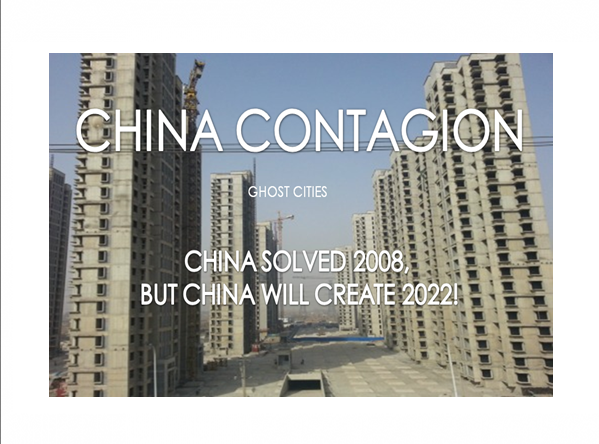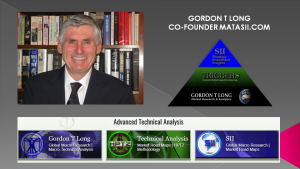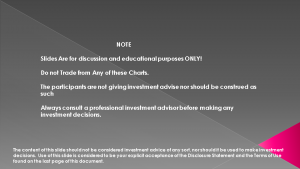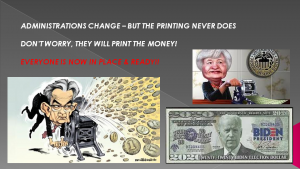IN-DEPTH: TRANSCRIPTION - UnderTheLens - NOVEMBER - China Contagion
SLIDE DECK
TRANSCRIPTION
SLIDE 2
Thank you for joining me. I'm Gord Long.
A REMINDER BEFORE WE BEGIN: DO NO NOT TRADE FROM ANY OF THESE SLIDES - they are COMMENTARY for educational and discussions purposes ONLY.
Always consult a professional financial advisor before making any investment decisions.
COVER
China appears to be lapsing into its most significant economic slowdown, not driven by pandemic disease, in a generation. There’s plenty to worry about in China which includes Xi Jinping’s leadership becoming distinctively authoritarian with shocking clampdowns on the private sector. Nervous western investors is not going to help China’s Investment led economy!
AGENDA
China has:
- Slowing economic growth,
- The credit overhang and potential for crisis in real estate thanks to the stricken China developer, the Evergrande Group,
- China’s problematic relationship with the West and the potential for another “Cold War”,
- Trade and the risk of deeper protectionism,
- And as I mentioned, the alarming leadership shift of Xi Jinping.
However, I want to go right to the central problem in China as I see it. That is an Investment led Investment Model which was allowed to get out of control and now threatens China falling from its perch, much as Japan did when it spiraled it into a multi-decade deflationary spiral.
The commonality being a massive Real Estate Bubble that imploded!
As such I would like to discuss the items outlined here.
SLIDE 5
We last discussed China in the spring when we talked about Covid triggering the next great financial crisis. A big part of that was about rising costs and razor thin margins in China. Inflation has only gotten worse along with severe power shortages and Covid reaping more damage with forced factory shutdowns further aggravating margins and placing pressures on increasing their export prices.
Added to shipping, US port and deliver price increases we are seeing the elevated prices in US import costs we warned of. Rising consumer prices in a 70% consumption economy like the US, while experiencing shrinking real disposable income is a recipe for a global demand shock at some point!
SLIDE 6
Today the situation in China has advanced, where further problems are clearly evident which will lead to China taking the world towards a period of Stagflation , or what we have been referring to here at MATASII.com as the “Great Stagflation”.
What we hope to leave with you in this session is the understanding that China’s structural problems; associated with is national Investment centric model; its regional & city dependency on “property” and the dominance of real estate wealth to the Chinese pubic has become a self reinforcing, culturally driven feedback loop that has resulted in a potentially serious global systemic problem.
This “loop” has massive implications on the Chinese Credit Impulse which since the 2008 financial crisis has been a major driver of global economic activity and certainly was central in lifting the world out of the 2008 Financial Crisis and most bumps in the road ever since.
A situation that will further aggravate global Supply and Demand Shocks which we recently discussed in our latest Macro Analytics video with Charles Hugh Smith entitled “Grab a Life Vest: Four Tsunami Waves Are About To Hit At Once”.
All of this must now be considered in the context of a major shift in direction by China’s leader Xi Jinping which is potentially and rapidly turning China from a global competitor into a global security threat!
SLIDE 7
Let’s start with China’s dependence on its Investment Model as opposed to the US’ Consumption Model. Both are fine if not taken to extremes. Unfortunately, in both cases they have been!
SLIDE 8
The rise in Chinese GDP since its entry into the WTO in 2002 has been nothing short of astounding! It is hard to imagine on the surface a bigger success story, in such a short period of time, especially if you consider it took its 1.4B population along the way without a major economic or social crisis.
SLIDE 9
Today based on Purchase Price Parity, China rivals the US as the global economic leader.
SLIDE 10
However, as I said China’s dramatic growth has been a result of growth in Investment Fixed Capital as shown on the right as compared to Household Consumption in the US as shown on the left.
China’s massive export growth, in becoming the global factory is no doubt important but it is the capital investment which it initially attracted to China as a result of over 60,000 factories leaving the US in a historic “off-shoring” push to capture labor arbitrage that was the real catalyst of its GDP growth.
Imports and exports with such small margins have frankly been more about employing $1.4B people and keeping the social fabric together with improving standards of living.
SLIDE 11
It is the “I” for Investment in the GDP formula!
SLIDE 12
Not the “C” for Consumption as in the US,
SLIDE 13
… remembering that the “G” for government in the US is the driver of transfer payments and entitlements now underpinning US consumption and that fiscal debt deficits underpins foreign investment or the “I” in the US.
SLIDE 14
This chart of percentage contribution of GDP growth in China illustrates how important Gross Capital Formation (in yellow) is to China. It compares to net exports of goods and services (shown in grey).
Final consumption expenditure in blue is now important but nothing compared to the US in importance.
SLIDE 15
What is now driving capital formation in China is real estate!
Over 70% of China’s wealth is now held in Real Estate.
The industry now accounts for about a third of gross domestic output and 40% of household assets.
China is about Property Development, Regional Infrastructure Investment and Housing!
SLIDE 16
How could that be a problem?
Well that starts with understanding who owns the land and the fact there are no property taxes in China to fund local and city infrastructure as there are in the developed world.
SLIDE 17
I thought Jim Chanos, a renowned short seller truly understands China when he said:
“When you have an investment-driven economic model, you know your annual GDP on January 1st of that year, because you can stick shovels in the ground to make your growth numbers. That’s how the model works.”
That is exactly what is going on with China’s economic reporting!
Why would you quite literally build massive numbers of “Ghost Cities”? I encourage you to do a Google search and see the magnitude of what you will discover.
China has, and continues to build massive public transportation projects and endless other public works that are unfunded and significantly under-utilized just on speculation, without recurring revenue streams to support the investment. This would be unheard of in any country other than China and would lead quickly to spectacular bankruptcy.
But not in China! Why?
SLIDE 18
With no property taxes to support local and city infrastructure where does the money come from and how does it pay the required ongoing support and maintenance services required for all these developments and infrastructure investments?
The money comes primarily from three sources.
- First, the sale of land to developers. The government owns all land and sells it as a dominate source of Capital Formation. Presto, you have capital formation!
- Secondly, Official Debt from Government controlled banks and lending,
- Thirdly, Hidden Debt from Various Special Purpose Entities, LICs & LGFVs (we will get to those in a moment). The same sort of entities that we are familiar with after the Dotcom Bubble Implosion and financial scandals such as Enron!
SLIDE 19
Direct borrowing by local governments is mostly restricted in China. In order to circumvent these restrictions, local governments have turned to affiliated organizations, such as Local Investment Companies (or LICs), to take on debt and finance projects. The result has been that local debts have become incredibly complex, difficult to track ….
SLIDE 20
and hidden. Since everything in China is opaque no one really knows what is going on .. maybe (and hopefully) other than the Chinese Communist Party (CCP)?
S&P Global Ratings' report on Oct. 16th shed light on the nationwide issue, stating that off-balance sheet debt in local governments could be as high as $4.5T, mostly in the form of Local Government Financing Vehicles (or LGFVs).
An S&P credit analyst is bravely on the record as recently leaking and I quote: “the potential amount of debt is an iceberg with titanic credit risks."
SLIDE 21
This is where it begins but this is actually just the tip of a very large iceberg!
SLIDE 22
This is because the real estate industry in China accounts for a third of GDP but 40% of all household assets and as I mentioned earlier, over 70% of China’s wealth.
SLIDE 23
The Chinese wealth management products (or WMPs) is the greatest Ponzi scheme in the history of the world. Chinese Retail investors are led to believe that WMPs are like bank deposits and are backed by the bank that sells them. They are not.
They’re actually unsecured units in blind pools that can be invested in anything the pool manager wants.
Most WMP funds have been invested in the real estate sector. This has led to asset bubbles in real estate (at best) and wasted developments that cannot cover their costs (at worst). When investors wanted their money back, the sponsor would simply sell more WMPs and use the money to pay back the redeeming investors. This is exactly the definition of a Ponzi scheme.
The total amount invested in WMPs is now in the trillions of dollars, used to finance thousands of projects sponsored by hundreds of major developers. Chinese investors are all-in with WMPs.
SLIDE 24
Now the entire edifice is fracturing and beginning to crumble!
The largest property developer in China, Evergrande, is quickly headed for bankruptcy. That’s a multibillion-dollar fiasco on its own. Evergrande losses will arise in:
- WMPs,
- Corporate debt,
- Unpaid contractor bills,
- Equity markets and
- Unfinished housing projects.
SLIDE 25
China’s entire property and financial system is on the verge of a world-historic crack-up. And it won’t remain limited to China.
SLIDE 26
Understand two facts:
- Unlike buying a house in the US where you put some money and the bulk when you close and move in. In China you put all your money into an WMP or housing investment and nothing has been built. All your money is up-front.
- Many Chinese buyers have now bought upwards of 8 housing units with their pyramided, supposed profits.
SLIDE 27
The leverage in reverse of falling property values will make the Bear Stearns, Lehman Mortgage Debacle of 2008 look like small potatoes!
SLIDE 28
China has tried three previous times over the last ten years to slow this bubble but failed.
SLIDE 29
It is trying again but so far has ended up with a Evergrande debacle
SLIDE 30
China’s GDP is currently being dramatically taken down as its GDP from housing plummets as shown in red.
This is a bubble that has been pricked. The CCP has the money and power to put patches on it but how effective will they be and how long will they last?
Remember, China’s Investment led Model is built on Real Estate and they can’t keep a lid on it for very long without severe consequences!
SLIDE 31
The CCP and China’s leader Xi Jinping are acutely aware of all this.
I can’t help but wonder if this is a source of his recent rapid and what appears to be accelerated shift in direction.
SLIDE 32
In the way of background:
- Xi Jinping in 2013 was initially seen as just the latest in a series of technocrats
- He would follow along with Deng Xiaoping’s reforms.
- It’s “Capitalism with Chinese characteristics.”
- “It’s okay to get rich as long as the country prospers”.
- Xi Jinping’s first speech in China after becoming president
- He was critical of the Soviet Union for being soft on perestroika.
- “They should have crushed it when they had the chance!”
- Xi then set up an institute to study the Soviet Union’s collapse.
- That was a red flag that he was going to be more hard-line than people thought.
SLIDE 33
- Xi Jinping then went on to do an anti-corruption drive
- He used the anti-corruption purge to sideline political rivals. People were dismissed as a typical settling of scores that Chinese leaders do.
- He cemented China as the regional superpower.
- He punished more than a million party members - which helped his popularity among some.
- He clamped down on many emerging freedoms, increasing its state surveillance and censorship programs.
- A couple of years later, he began talking in Puritanical terms about social issues.
- Nobody had cared about that stuff for 20 years.
- The message was: “Do what you want as long as you don’t question the party!”
SLIDE 34
- Xi Jinping next had the bookcollecting his speeches and writings,
- People could be seen carrying it around like Mao’s.
- He started showing up in military events dressed in Mao jackets. This sort of symbolism isn’t lost in China.
- In 2018 China allowed Xi to remain 'president for life' as the 2 term limits were removed.
- Xi immediately consolidated his political power as the party voted to enshrine his name and political ideology in the party's constitution - elevating his status to the level of its founder, Chairman Mao.
- The real switch then occurred in 2019
- He then started going after celebrities like Jack Ma [co-founder of Alibaba].
- He was taking a much harder line on the “flowers of capitalism,” if you will, than past presidents.
- Xi Jinping’s “thought” is the ideology approved by the Communist Party last October.
- Officially, it is "Xi Jinping Thought on Socialism with Chinese Characteristics for the New Era".
SLIDE 35
- With Xi’s “New Thought on Socialism, all of this exploded into the open.
- There’s been initiative after initiative.
- Redistributing wealth to the masses.
- Going after other leaders.
- Overlaid on top of this is the Evergrande saga.
- George Soros (the elitist voice for Globalism) Spoke out Strongly in UK’s Financial Times & US WSJ (the paper of record for the Davos Global elite) (and I quote):
- “Xi believes Mao Zedong invented a superior form of organization, which he is carrying on: a totalitarian closed society in which the individual is subordinated to the one-party state. It is superior, in this view, because it is more disciplined, stronger and therefore bound to prevail in a contest.”
- “Relations between China and the U.S. are rapidly deteriorating and may lead to war. Xi has made clear that he intends to take possession of Taiwan within the next decade, and he is increasing China’s military capacity accordingly.”
- “I consider Xi the most dangerous enemy of open societies in the world. The Chinese people as a whole are among his victims, but domestic political opponents and religious and ethnic minorities suffer from his persecution much more. ”
These are pretty damming words and a clear message.”It is time to reconsider your capital being invested in or held by China – if you expect to get it back!”
SLIDE 36
Xi Jinping knows his power it at its greatest and the Investment led model must change, but getting from here to there is a big step. A step that will cost him and his party power if it is not handled boldly and on a large enough scale.
SLIDE 37
China’s annualized 2 year change for both retail sales and industrial production have been on a steady decline for nearly 10 years now.
SLIDE 38
Its struggle with managing Credit Growth has resulted in a steady overall slowing Y-o-Y credit growth
SLIDE 39
The Chinese Credit Impulse is telling us that the world will soon feel the impact of China’s restrictive credit policies (it lags by 12 months) even without the potential fallout from a Real Estate sector letting out air, which will make this impulse even worse .. much worse.
SLIDE 40
The question is what is likely ahead and what will it mean for investors.
SLIDE 41
So far the world is expressing its concern through its investment decisions. Chinese ADR’s have fallen massively out of favor at least in the US
SLIDE 42
Stocks with the greatest Chinese exposures have also fallen badly so far this year while US and other country stocks reached historic levels while mounting a post Pandemic recovery.
SLIDE 43
Shanghai shares have fallen relative to the S&P 500. The red annotations show this is based on Chinese policy decisions to:
- The NPC lower GDP outlook and asset bubble warning,
- The crackdown on technology and education sectors
- The video gaming ban,
- Emphasize on “Common Prosperity”,
- The Macau Crackdown.
SLIDE 44
I think this chart reflecting how the Chinese Credit Impulse leads commodity futures tells us a lot about what is ahead.
The good news is inflation pressures from materials may tame.
The bad news is that is all the good news .. everything else portends badly for both China and the rest of the world!
The credit and liquidity engine for the world has more than a serious sniffle. Even a sniffle however usually means a cold (or worse) for the rest of the world!
SLIDE 45
As I always remind you in these videos, remember politicians and Central Banks will print the money to solve any and all problems, until such time as no one will take the money or it is of no value.
That day is still in the future so take advantage of the opportunities as they currently exist.
Investing is always easier when you know with relative certainty how the powers to be will react. Your chances of success go up dramatically.
The powers to be are now effectively trapped by policies of fiat currencies, unsound money, political polarization and global policy paralysis.
SLIDE 46
I would like take a moment as a reminder
DO NO NOT TRADE FROM ANY OF THESE SLIDES - they are for educational and discussions purposes ONLY.
As negative as these comments often are, there has seldom been a better time for investing. However, it requires careful analysis and not following what have traditionally been the true and tried approaches.
Do your reading and make sure you have a knowledgeable and well informed financial advisor.
So until we talk again, may 2021 turn out to be an outstanding investment year for you and your family.
Thank you for listening





